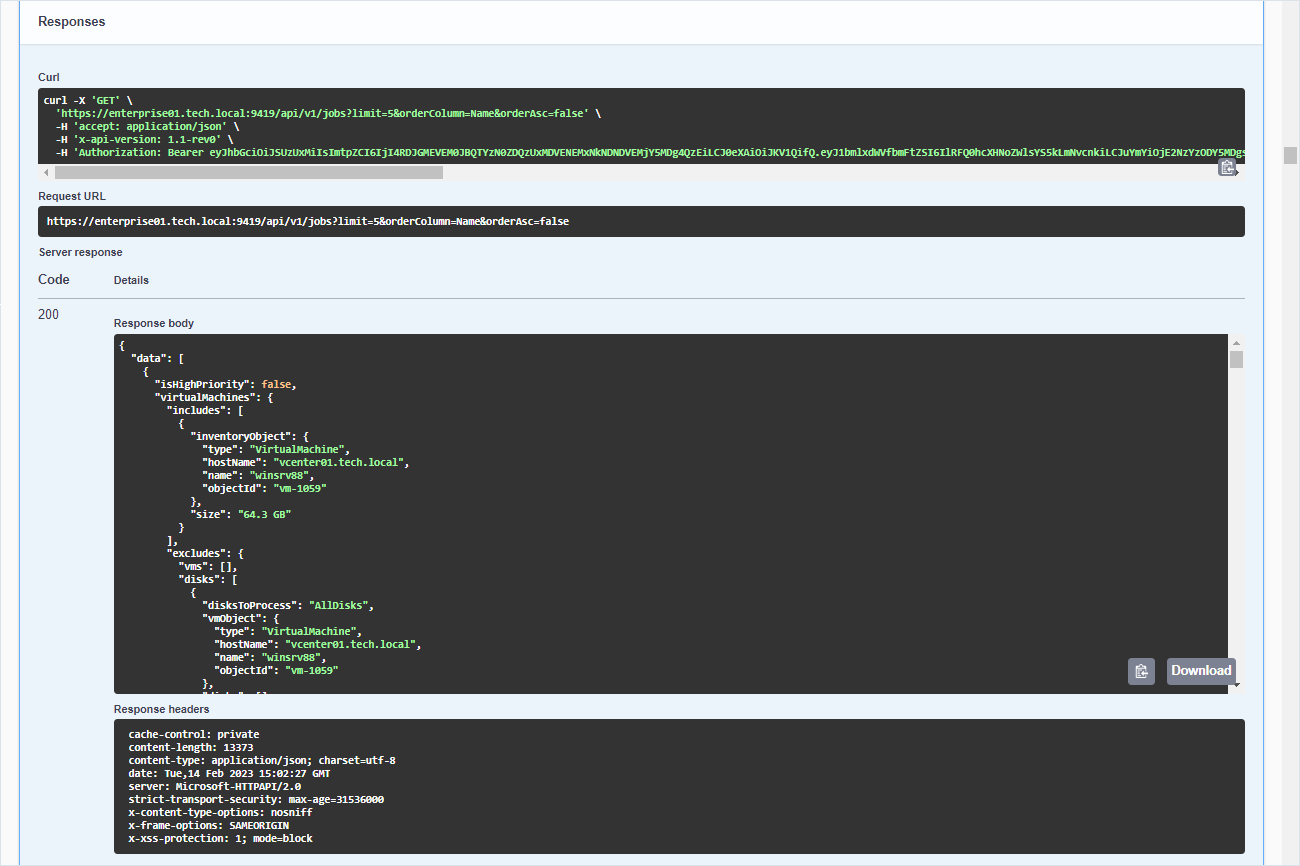- About Veeam Backup & Replication REST API
- Overview
- How To
- Changelog
- Login
- Service
- Services
- Credentials
- getGet All Credentials
- postAdd Credentials Record
- getGet Credentials Record
- putEdit Credentials Record
- delRemove Credentials Record
- postChange Password
- postChange Linux Private Key
- postChange Linux Root Password
- getGet All Cloud Credentials
- postAdd Cloud Credentials Record
- postGet Microsoft Entra ID Verification Code
- postRegister Microsoft Entra ID Application
- postGet Google Authentication Information
- getGet Cloud Credentials Record
- putEdit Cloud Credentials Record
- delRemove Cloud Credentials Record
- postChange Secret Key
- postChange Google Service Account
- postChange Certificate
- getGet All Helper Appliances
- postAdd or Edit Helper Appliance
- getGet Helper Appliance
- delRemove Helper Appliance
- Encryption
- getGet All Encryption Passwords
- postAdd Encryption Password
- getGet Encryption Password
- putEdit Encryption Password Hint
- delRemove Encryption Password
- postChange Encryption Password
- postVerify Encryption Password
- getGet All KMS Servers
- postAdd KMS Server
- getGet KMS Server
- putEdit KMS Server
- delRemove KMS Server
- postChange KMS Server Certificate
- License
- postInstall License
- getGet Installed License
- postRemove License
- postCreate License Usage Report
- postRenew Installed License
- getGet Consumption of Socket Licenses
- postRevoke Socket License
- getGet Instance Licenses Consumption
- postAssign Instance License
- postRevoke Instance License
- postRemove Instance License
- getGet Capacity License Consumption
- postRevoke Capacity License From Unstructured Data Workload
- postUpdate License
- postEnable or Disable License Auto Update
- postEnable or Disable Instance Consumption for Unlicensed Agents
- Connection
- Cloud Browser
- Inventory Browser
- getGet All VMware vSphere Servers
- getGet VMware vSphere Server Objects
- postRescan Inventory Objects
- postGet All Servers
- postGet Inventory Objects
- postGet All Protection Groups
- postGet Inventory Objects for Specific Protection Group
- getGet All Unstructured Data Servers
- getGet Unstructured Data Servers
- getGet All Microsoft Entra ID Tenants
- postAdd Microsoft Entra ID Tenant
- getGet Microsoft Entra ID Tenant
- putEdit Microsoft Entra ID Tenant
- delRemove Microsoft Entra ID Tenant
- getGet Active Directory Objects from Domain
- Traffic Rules
- General Options
- Global Exclusions
- Security
- postStart Security & Compliance Analyzer
- getGet Security & Compliance Analyzer Last Run
- getGet Security & Compliance Analyzer Schedule
- putModify Security & Compliance Analyzer Schedule
- postReset All Security & Compliance Analyzer Statuses
- getGet Security & Compliance Analyzer Results
- postSuppress Security & Compliance Analyzer Best Practice Status
- postReset Security & Compliance Analyzer Status
- getGet All Authorization Events
- getGet Authorization Event
- Malware Detection
- Configuration Backup
- Deployment
- Managed Servers
- getGet All Servers
- postAdd Server
- postGet vCenter Servers Attached to Cloud Director Server
- postGet Hyper-V Servers Managed by Hyper-V Cluster or SCVMM Server
- getGet Server
- putEdit Server
- delRemove Server
- postChange to Single-Use Credentials
- getGet Volumes for Hyper-V Standalone Server
- putEdit Volumes on Hyper-V Standalone Server
- postRescan All Managed Servers
- postRescan Managed Server
- getDefault Set of Optional Managed Server Components
- postUpdate Managed Server Components
- Repositories
- getGet All Repositories
- postAdd Repository
- postRescan Repositories
- getGet All Repository States
- getGet Repository
- putEdit Repository
- delRemove Repository
- getGet All Scale-Out Backup Repositories
- postAdd Scale-Out Backup Repository
- getGet Scale-Out Backup Repository
- putEdit Scale-Out Backup Repository
- delRemove Scale-Out Backup Repository
- postEnable Sealed Mode
- postDisable Sealed Mode
- postEnable Maintenance Mode
- postDisable Maintenance Mode
- Mount Servers
- Proxies
- WAN Accelerators
- Jobs
- Backups
- Backup Objects
- Restore Points
- Restore
- getGet All Instant Recovery Mount Points of VMware vSphere VMs
- postStart Instant Recovery of VMware vSphere VM
- getGet Instant Recovery Mount Point of VMware vSphere VM
- postStop Publishing VMware vSphere VM
- postStart Migrating VMware vSphere VM
- getGet All Instant Recovery Mount Points of Microsoft Hyper-V VMs
- postStart Instant Recovery of Microsoft Hyper-V VM
- getGet Instant Recovery Mount Point of Microsoft Hyper-V VM
- postStop Publishing Microsoft Hyper-V VM
- postStart Migrating Microsoft Hyper-V VM
- getGet All Mount Points for Instant Recovery to Azure
- postStart Instant Recovery to Azure
- getGet Mount Point for Instant Recovery to Azure
- getGet All Mount Sessions for Instant Recovery to Azure
- postStop Publishing Machine to Azure
- postStart Migrating Machine to Azure
- getGet Settings for Switchover to Azure
- putUpdate Settings for Switchover to Azure
- postStart Switchover to Azure
- postRestore Entire VMware vSphere VM
- postRestore Entire VMware Cloud Director VM
- postRestore Entire Microsoft Hyper-V VM
- getGet All FCD Mount Points
- postStart Instant FCD Recovery
- getGet FCD Mount Point
- postStop FCD Publishing
- postStart FCD Migration
- postStart File Restore
- postUnmount File System
- postGet User Code for Delegated Restore of Microsoft Entra ID Items
- postGet Credentials for Delegated Restore of Microsoft Entra ID Items
- postMount Microsoft Entra ID Tenant
- postStart Microsoft Entra ID Tenant Restore from Copy
- postUnmount Microsoft Entra ID Tenant
- postStart Microsoft Entra ID Audit Log Restore
- postUnmount Microsoft Entra ID Audit Logs
- Data Integration API
- Backup Browsers
- postValidate Target Machine Credentials
- getGet All File Restore Mount Points
- getGet File Restore Mount Point
- getGet Restored Files Audit
- postBrowse File System
- postCompare Attributes
- postCompare Files and Folders
- postSearch for Files and Folders
- postBrowse Search Results
- postRestore Files and Folders to Original Location
- postRestore Files and Folders to Another Location
- postPrepare Files and Folders for Download
- postDownload Files and Folders
- getGet All Unstructured Data Mount Points
- getGet Unstructured Data Mount Point
- postBrowse Unstructured Data File System
- postSearch for Files and Folders in Unstructured Data Source
- postBrowse Search Results
- postCopy Files and Folders to Specific Folder
- getGet Mount Points of All Entra ID Tenants
- getGet Mount Point of Microsoft Entra ID Tenant
- postGet Restore Points of Microsoft Entra ID Tenant
- getGet Protection Scope of Microsoft Entra ID Tenant
- postGet Microsoft Entra ID Items
- postGet Microsoft Entra ID Item
- postGet Restore Points of Microsoft Entra ID Item
- postValidate Microsoft Entra ID Items
- postCheck Microsoft Entra ID Items in Production
- postGenerate Microsoft Entra ID User Passwords
- postRestore Microsoft Entra ID Items
- postRestore Microsoft Entra ID Item Properties
- postCompare Microsoft Entra ID Item Properties
- postStart Comparing Microsoft Entra ID Item Properties
- getGet Comparison Results for Microsoft Entra ID Items
- postStart Comparing Microsoft Entra ID Conditional Access Policy
- getGet Comparison Results for Microsoft Entra ID Conditional Access Policy
- postExport Microsoft Entra ID Items
- postUpload Microsoft Entra ID Users
- postUpload Microsoft Entra ID Groups
- postUpload Microsoft Entra ID Administrative Units
- postUpload Microsoft Entra ID Roles
- postUpload Microsoft Entra ID Applications
- postUpload Microsoft Entra ID Conditional Access Policies
- getGet All Restore Sessions of Microsoft Entra ID Tenant
- getGet Restore Session of Microsoft Entra ID Tenant
- getGet Restore Session Logs of Microsoft Entra ID Tenant
- postStop Restore Session of Microsoft Entra ID Tenant
- Tasks
- Replicas
- Replica Restore Points
- Failover
- Failback
- Sessions
- Agents
- getGet All Recovery Tokens
- postCreate Recovery Token
- getGet Recovery Token
- putEdit Recovery Token
- delDelete Recovery Token
- getGet All Protected Linux Computers
- getGet Protected Linux Computer
- getGet Discovered Entities
- postRescan Discovered Entities
- postInstall Agent on Discovered Entities
- postUninstall Agent from Discovered Entities
- postUninstall All Components from Discovered Entities
- getGet Discovered Entity
- delRemove Discovered Entity
- getGet Linux Agent Packages
- getGet Unix Agent Packages
- Protection Groups
- Active Directory Domains
- Automation
- postImport Jobs
- postExport Jobs
- postImport Credentials
- postExport Credentials
- postImport Cloud Credentials
- postExport Cloud Credentials
- postImport Proxies
- postExport Proxies
- postImport Servers
- postExport Servers
- postImport Repositories
- postExport Repositories
- postImport Encryption Passwords
- postExport Encryption Passwords
- getGet All Automation Sessions
- getGet Automation Session
- getGet Automation Session Logs
- postStop Automation Session
- Log export
The following topics will help you learn how to connect to the REST API and authorize your access, and how to control and sort the data that the REST API returns.
Each Veeam Backup & Replication REST API-exposed entity has a resource representing it. To get a resource representation, request its URL.
The Veeam Backup & Replication REST API requests use the following base URL format:
https://<hostname>:<port>/api/<version>
where:
<hostname>is a public IPv4 address or DNS hostname of the machine where Veeam Backup & Replication is installed.<port>is the REST API port number set during Veeam Backup & Replication installation.
The default port number is 9419.
<version>is an API version.
The current major version is v1.
To get a collection of Veeam Backup & Replication REST API resources, request the base URL followed by a resource collection endpoint. For example:
https://enterprise01.tech.local:9419/api/v1/sessions
To get a representation of an individual resource, specify a resource identifier after the resource collection endpoint. For example:
https://enterprise01.tech.local:9419/api/v1/sessions/c36824e9-0c3e-4892-8dff-44fd56968506
The resource identifier is represented by the id property of the resource. For example:
[
{
...
"id": "c36824e9-0c3e-4892-8dff-44fd56968506",
"name": "Infrastructure",
...
,
},
{
...
"id": "e170b7a4-0375-41b1-b066-d4be19d7b7ce",
"name": "Backup Job 1",
...
}
]
Veeam Backup & Replication REST API is backward-compatible. This means that, in general, client requests that use an earlier version or revision of the REST API are compatible with further REST API updates. You can find the current Veeam Backup & Replication REST API version and revision in the REST API specification. It is specified in the version field of the info object. For example:
"version": "1.3-rev0"
The table below lists the REST API revisions, their support statuses, and the Veeam Backup & Replication build numbers when the REST API revisions were released.
The Deprecated support status is intermediate. Deprecated REST API revisions are expected to become unsupported. You can still use them but it is recommended that you switch to a newer one.
| REST API Revision | Support Status | Veeam Backup & Replication Build |
|---|---|---|
| 1.3-rev0 | Supported | 13.0.0.4967 |
| 1.2-rev1 | Supported | 12.3.1.1139 |
| 1.2-rev0 | Supported | 12.3.0.310 |
| 1.1-rev2 | Supported | 12.2.0.334 |
| 1.1-rev1 | Supported | 12.1.0.2131 |
| 1.1-rev0 | Supported | 12.0.0.1420 |
| 1.0-rev2 | Deprecated | 11.0.1.1261 |
| 1.0-rev1 | Deprecated | 11.0.0.837 |
You must specify the Veeam Backup & Replication REST API version and revision in each request. The requirement lets you minimize changes in your client application with every REST API update.
Veeam Backup & Replication REST API implements a combined approach of versioning:
Major version is specified in the request path in the following format:
v<major_version>. The current major version isv1.Version and revision are specified in the request header in the following format:
<version>-<revision>. For example,1.3-rev0.
For example, to obtain current date and time on the backup server, send the HTTP GET request to the api/<major_version>/serverTime path. In the x-api-version header, specify a version and revision in the following format: <version>-<revision>.
Request
GET https://enterprise01.tech.local:9419/api/v1/serverTime
Request Header
x-api-version:1.3-rev0
Communication between the client and Veeam Backup & Replication REST API is established over HTTPS. To ensure data privacy, unencrypted HTTP is not supported. The client verifies the REST API identity with a server TLS certificate. For details on managing certificates, see TLS Certificate.
Authorization in REST API
Authorization process of the REST API is based on the OAuth 2.0 Authorization Framework and involves obtaining an access token and a refresh token.
- Access token is a string that represents authorization issued to the client. It must be specified in all requests during the current logon session.
- Refresh token is a string that represents authorization granted to the client. It is used to obtain a new access token if the current access token expires or becomes lost.
The authorization process involves the following procedures:
Credentials Lifetime
The access token, refresh token and authorization code have their default lifetime after which they expire. The lifetime starts from the time the authorization response was generated.
| Credential | Lifetime |
|---|---|
| Access token | 60 minutes |
| Refresh token | 14 days |
To get access to the REST API resources, the client obtains an access token — a string that denotes client access attributes and that must be specified in all requests to the REST API.
The Veeam Backup & Replication REST API accepts password grant type authorization, which allows you to get an access token by providing a user name and password.
Example
To get an access token and a refresh token send the HTTP POST request to the /api/oauth2/token path. In the x-api-version header, specify the current revision of the Veeam Backup & Replication REST API.
In the request body, specify the following parameters:
| Parameter | Value | Description |
|---|---|---|
grant_type |
password |
Authorization grant type |
username |
<Username> |
Account name used to access the backup server |
password |
<Password> |
Account password |
Request
POST https://enterprise01.tech.local:9419/api/oauth2/token
Request Header
x-api-version:1.3-rev0
Request Body
grant_type=password&username=administrator&password=Password1
A successfully completed operation returns the 200 response code. In the response body, Veeam Backup & Replication returns an access token, its expiration time (in seconds) and a refresh token. Specify the access token in headers of further requests to the Veeam Backup & Replication REST API. The refresh token must be saved locally.
Response
200
Response Body
{
"access_token": "eyJhbGciOiJSUzUxMiIsImtpZCI6IjQ2MDU0QjExNTE3Njk0QzAxN0IyRTE2MTQyNURCRDM1QkNGNzY3NkQiLCJ0eXAiOiJKV1QifQ.eyJ1bmlxdWVfbmFtZSI6InVzZXIiLCJuYmYiOjE1ODY...",
"token_type": "bearer",
"refresh_token": "eyJhbGciOiJSUzUxMiIsImtpZCI6IjQ2MDU0QjExNTE3Njk0QzAxN0IyRTE2MTQyNURCRDM1QkNGNzY3NkQiLCJ0eXAiOiJKV1QifQ.eyJ1bmlxdWVfbmFtZSI6InVzZXIiLCJ0b2tlbl9pZCI...",
"expires_in": 900,
".issued": "2025-06-10T10:29:39",
".expires": "2025-06-10T10:44:39",
"username": "administrator"
}
Refresh token is a token used to refresh an expired or lost access token.
To refresh an access token, send the HTTP POST request to the /api/oauth2/token path. In the request body, specify the following parameters:
| Parameter | Value | Description |
|---|---|---|
grant_type |
refresh_token |
Authorization grant type |
refresh_token |
<Refresh token> |
Previously saved refresh token |
A successfully completed operation returns the 200 response code and a new pair of tokens in the response body.
If you have lost a refresh token, you can log in again under the same user account and get a new pair of tokens.
Example
To refresh an access token, send the HTTP POST request to the api/oauth2/token path. In the x-api-version header, specify the current revision of the Veeam Backup & Replication REST API.
In the body of the request, specify the refresh_token grant type and the refresh token itself.
Request
POST https://enterprise01.tech.local:9419/api/oauth2/token
Request Header
x-api-version:1.3-rev0
Request Body
grant_type=refresh_token&refresh_token=eyJhbGciOiJSUzUxMiIsImtpZCI6IjQ2MDU0QjExNTE3Njk0QzAxN0IyRTE2MTQyNURCRDM1QkNGNzY3NkQiLCJ0eXAiOiJKV1QifQ.eyJ1bmlxdWVfbmFtZSI6InVzZXIiLCJ0b2tlbl9pZCI6ImQ5ZDhiN2RlLWIwYjUtNDc1Yi04ZTE4LTU4ZGMzMzVmOWIzNSIsInNob3J0X3Rl...
You receive a response in the following format.
Response
200
Response Body
{
"access_token": "eyJhbGciOiJSUzUxMiIsImtpZCI6IjQ2MDU0QjExNTE3Njk0QzAxN0IyRTE2MTQyNURCRDM1QkNGNzY3NkQiLCJ0eXAiOiJKV1QifQ.eyJ1bmlxdWVfbmFtZSI6InVzZXIiLCJuYmYiOjE1ODYyNTU3ODMsImV4cCI6MTU4NjI1NjY4MywiaWF0IjoxNTg2MjU1NzgzLCJhdWQiO...",
"token_type": "bearer",
"refresh_token": "eyJhbGciOiJSUzUxMiIsImtpZCI6IjQ2MDU0QjExNTE3Njk0QzAxN0IyRTE2MTQyNURCRDM1QkNGNzY3NkQiLCJ0eXAiOiJKV1QifQ.eyJ1bmlxdWVfbmFtZSI6InVzZXIiLCJ0b2tlbl9pZCI6ImI5MjJhNGJiLTJmY2YtNGMwZi1hZGMxLTg2M2I4YzY1MzkxMiIsInNob3J0X3...",
"expires_in": 900,
".issued": "2025-04-07T10:36:23",
".expires": "2025-04-07T10:51:23"
}
To log out, send the HTTP POST request to the api/oauth2/logout path. After you log out, access and refresh tokens are expired. A successfully completed operation returns the 200 response code.
Example
To log out, send the HTTP POST request to the api/oauth2/logout path. In the x-api-version header, specify the current revision of the Veeam Backup & Replication REST API, in the Authorization header — currently valid access token in the Bearer <access_token> format.
Request
POST https://enterprise01.tech.local:9419/api/oauth2/logout
Request Header
x-api-version:1.3-rev0
Authorization: Bearer YSEoaL6H9EEyJpnrJ9WhLtzbrrBBYWqMQFDBQuLnp13qGQX6MjNfZ_wriPIRHQrbY-8dYtsWcRZQczIHVuSqbnVb00m-yOihPZZHQ48aP1VcgUtgnYTvtAO3WRJ1cJ8VaIXzsV...
You receive a response in the following format.
Response
200
Communication between the client and Veeam Backup & Replication REST API is established over HTTPS. To ensure data privacy, unencrypted HTTP is not supported. The client verifies the REST API identity with a server TLS certificate. The REST API uses the certificate of Veeam Backup & Replication.
During the Veeam Backup & Replication installation, a self-signed TLS certificate is created and bound to the REST API and the 9419 port.
If the existing TLS certificate expires, or if you want to use another certificate (for example, the one obtained from a Certificate Authority), you can add a new certificate. For details, see Updating TLS Certificate.
To view the TLS certificate, use the Get Backup Server Certificate request.
Updating TLS Certificate
If the existing TLS certificate expires, you need to install a new one using the Veeam Backup & Replication console or Veeam PowerShell. For details, see the Backup Server Certificate section of the Veeam Backup & Replication User Guide and the Add-VBRBackupServerCertificate section of the Veeam PowerShell Reference.
To perform REST API operations, use the following standard HTTP methods:
| Method | Description | Example |
|---|---|---|
GET |
Retrieves information about a resource or collection | Get All Jobs |
POST |
Creates a new resource in a collection or activates a resource action. | Create Job |
PUT |
Makes changes to a resource | Edit Job |
DELETE |
Removes a resource from a collection. | Delete Job |
HTTP headers let the client and the server pass additional information with HTTP requests or responses. An HTTP header consists of a case-insensitive name and header value. The colon : separates the name and the value of the header.
When you send HTTP requests to the REST API, specify the following header parameters. All headers are required except the Content-Type header, which is required only if you specify a request body.
| Header | Sample Value | Description |
|---|---|---|
Authorization |
Bearer eyJhbGciOi... |
Authenticates the client that sends the request to the server. The header must contain an access token in the following format: Bearer <access token>. |
x-api-version |
1.3-rev0 |
Specifies the version and revision of the REST API. |
Content-Type |
application/json |
Identifies the media type of the request body. The REST API supports the following media types:
|
Accept |
application/json |
Specifies the media type of the response body. The REST API supports only the application/json media type. |
In response, the server passes the following header parameters.
| Header | Sample Value | Description |
|---|---|---|
Cache-Control |
private | Specifies the private caching type (tied to the client) for requests and responses. |
Content-Length |
20256 | Identifies the length of the response body, in bytes. |
Content-Type |
application/json; charset=utf-8 | Identifies the media type and encoding of the response body. The REST API supports only the application/json media type. |
X-Frame-Options |
SAMEORIGIN | Blocks clickjacking attacks. |
X-XSS-Protection |
1; mode=block | Prevents reflected cross-site scripting attacks. |
Strict-Transport-Security |
max-age=31536000 | Identifies that the server should only be accessed over HTTPS and specifies the time, in seconds, that the client should remember this requirement. |
X-Content-Type-Options |
nosniff | Blocks media type sniffing. |
Date |
Thu, 13 Apr 2025 14:35:46 GMT | The date and time the response was sent. |
Query parameters help you control the amount and order of data that the Veeam Backup & Replication REST API returns for a resource or collection. Query parameters are part of the URL that you specify in the request. The question mark ? separates query parameters from a resource collection path.
All query parameters are case-sensitive.
You can use the following query parameters:
You can use the skip query parameter to exclude the first N collection items from a response body.
For example, to return a list of sessions starting from the third one in the /sessions collection, send the following request:
GET https://enterprise01.tech.local:9419/api/v1/sessions?skip=2
You can combine the limit and the skip query parameters to request a particular set of items. Note that the skip parameter is applied before the limit parameter, regardless of the parameter position in the request. That is, top results are selected from a collection where a set of items is already excluded.
The Veeam Backup & Replication REST API returns resources in the default order based on its own semantics. To sort or filter a collection before excluding results, use sort and filter parameters. Note that sort and filter parameters are applied before the skip parameter, regardless of their position in the request. That is, a collection is first filtered or sorted, and then the top results are excluded.
You can use the limit query parameter to specify the maximum number of items of a resource collection to return in a response.
For example, to return only the first 3 sessions, send the following request:
GET https://enterprise01.tech.local:9419/api/v1/sessions?limit=3
The Veeam Backup & Replication REST API returns resources in the default order based on its own semantics. To sort or filter a collection before excluding results, use sort and filter parameters. Note that sort and filter parameters are applied before the limit parameter, regardless of their position in the request. That is, a collection is first filtered or sorted, and then the top results are selected.
You can use the orderColumn and orderAsc query parameters to sort items of a resource collection in a response.
Some resource properties of Veeam Backup & Replication REST API schemas can be used as parameter values for the orderColumn query parameter.
If the value of the orderAsc parameter is true, items are sorted in the ascending order by the orderColumn parameter. If the value is false, the items are sorted in the descending order.
For example, to sort sessions by session type in the ascending order, send the following request:
GET https://enterprise01.tech.local:9419/api/v1/sessions?orderColumn=SessionType&orderAsc=true
You can use filter query parameters to filter items of a resource collection to return a subset of resources in a response. The subset includes only those resources that satisfy parameter value specified in the query.
nameFilter
The nameFilter query parameter is used to filter items by the substring specified as the nameFilter value. The substring can be a part of any resource parameter.
To filter items, use the following methods:
- In the
nameFilterparameter, specify a full string that must match one of the item parameters. - In the
nameFilterparameter, specify a substring that one of the item parameters must contain. To do this, use the asterisk*character at the beginning of thenameFiltervalue, at the end or both.
For example, to return a list of sessions that contain the Working substring in any of their parameters, send the following request:
GET https://enterprise01.tech.local:9419/api/v1/sessions?nameFilter=*Working*
Other Filter Parameters
Some resource properties of Veeam Backup & Replication REST API schemas can be used as filter query parameters.
For example, to return a list of job sessions, specify the Job value of the typeFilter parameter in the following request:
GET https://enterprise01.tech.local:9419/api/v1/sessions?typeFilter=Job
To start working with the Veeam Backup & Replication REST API, you can use any client application that supports the HTTPS protocol. In addition, the REST API is available through Swagger UI, a web-based tool that you can use to evaluate and explore the REST API capabilities. Swagger UI visually represents the API specification file and enables you to interact with API endpoints directly from the browser.
The Veeam Backup & Replication REST API is defined in the swagger.json file. You can find the file in the Veeam Backup & Replication installation folder.
To access the REST API Swagger UI, use a web browser:
Navigate to the following URL:
https://<hostname>:<port>/swagger/index.htmlwhere:
<hostname>is a public IPv4 address or DNS hostname of the machine where Veeam Backup & Replication is installed.<port>is the REST API port number set during Veeam Backup & Replication installation.The default port is 9419.
From the Select a definition list, select the REST API version you need.
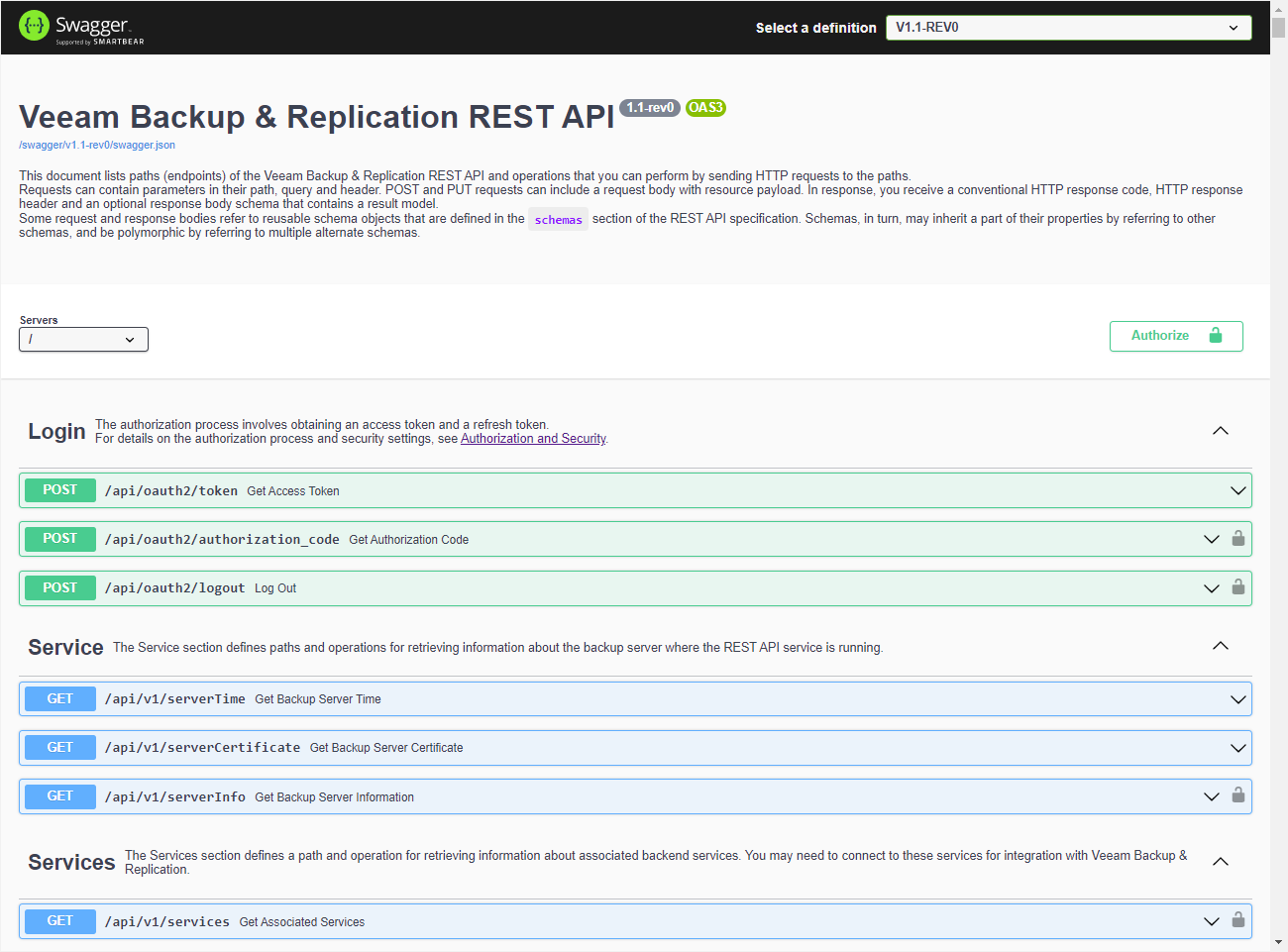
Veeam Backup & Replication REST API authorization with the Swagger UI involves the following procedures:
Obtain an access token and a refresh token:
On the Veeam Backup & Replication REST API page, expand the Login section and click POST api/oauth2/token.
In the expanded method window, click Try it out.
From the grant_type drop-down list, select password.
In the username and password fields, specify the credentials of a user created in Veeam Backup & Replication.
Click Execute.
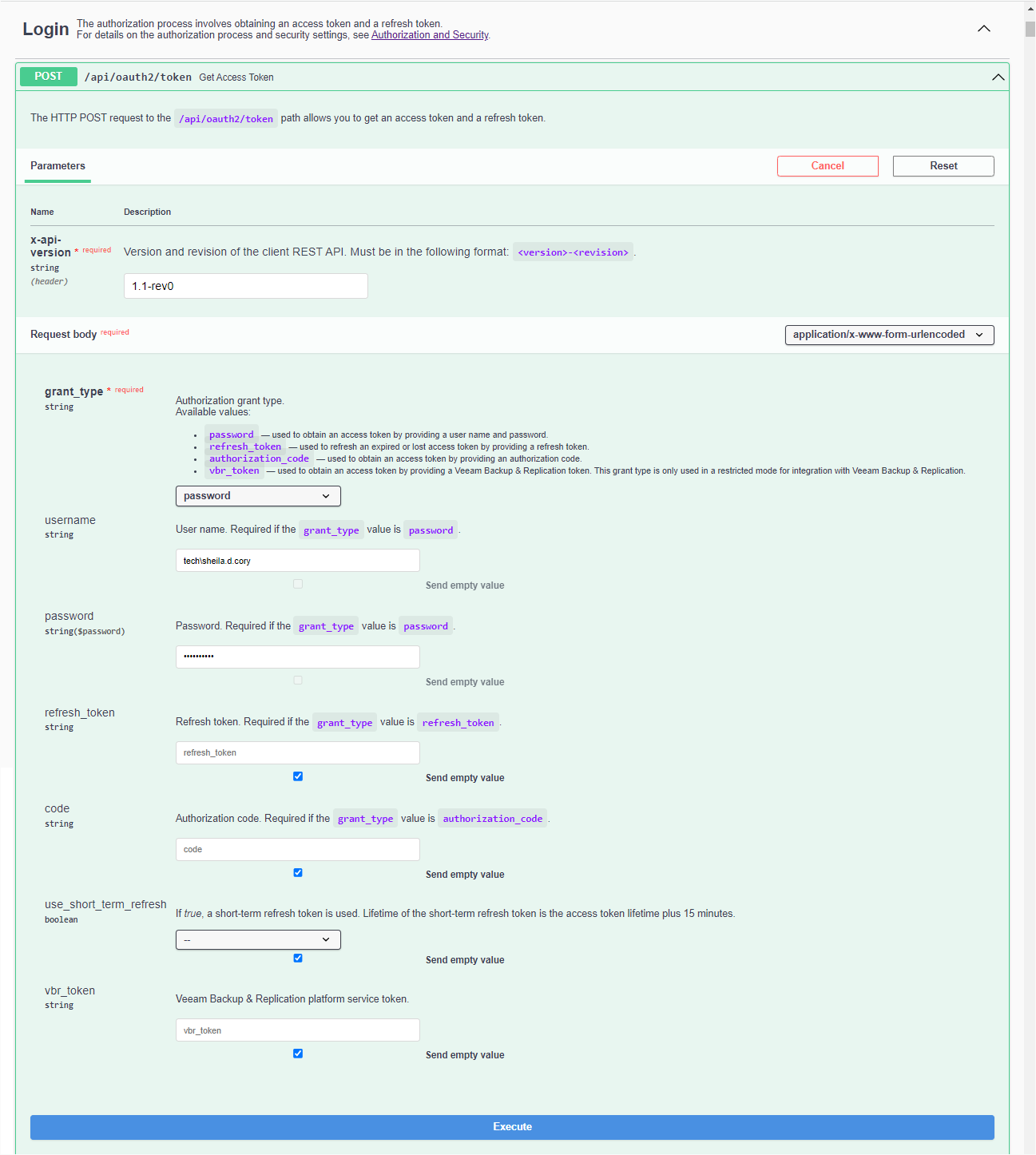
Wait for the response from the server. A successfully completed operation returns the 200 response code. In the response body, Veeam Backup & Replication returns an access token, its expiration time and a refresh token.
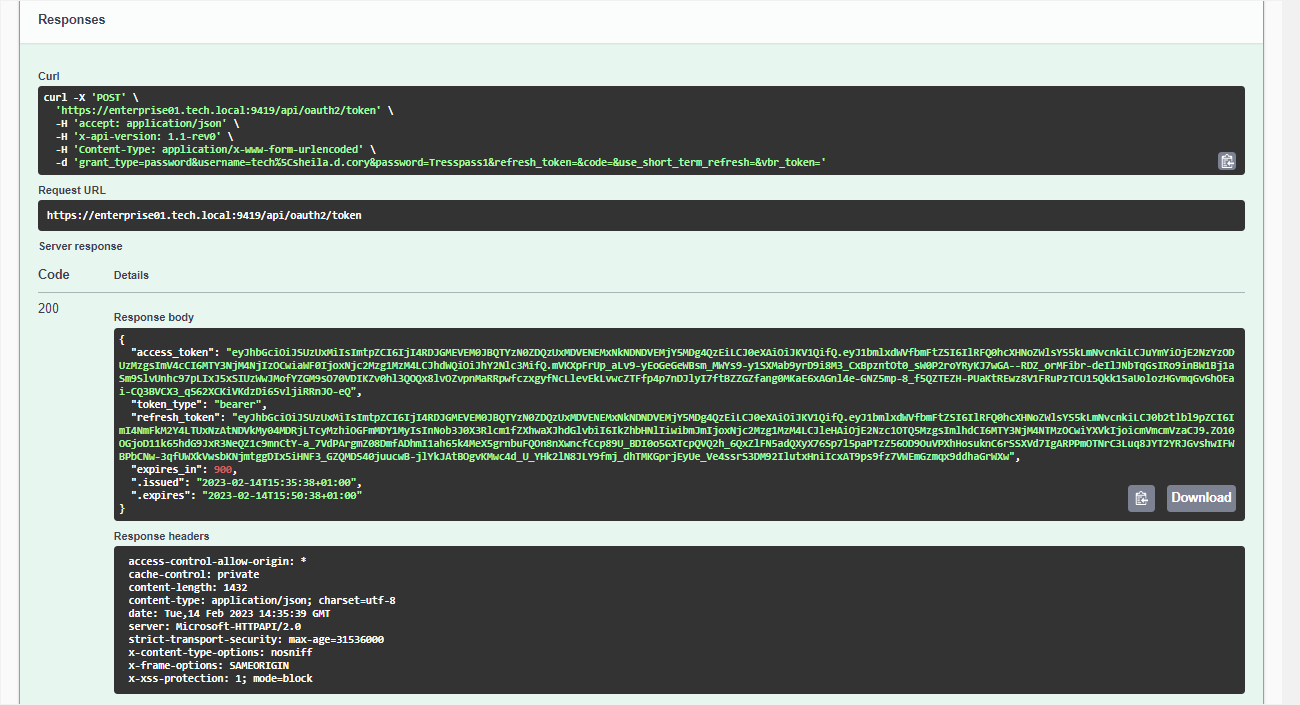
Save the access and refresh tokens locally for further use.
TIP
You can download a server response in the JSON format. To do that, in the expanded method window, click Download at the lower right corner of the Response body field.
Authorize your access in the Swagger UI:
At the top right corner of the Veeam Backup & Replication REST API page, click Authorize.
In the Available authorizations window, insert the access token saved locally in the Value field.
- If you use revision 1.2-rev1 or later, provide only the token itself.
- For all earlier revisions, use the
Bearer <access_token>format.
Click Authorize.
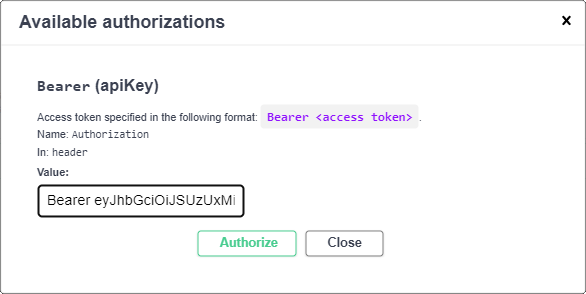
When the access token expires, use the refresh token:
On the Veeam Backup & Replication REST API page, expand the Login resource and click POST api/oauth2/token.
In the expanded method window, click Try it out.
From the grant_type drop-down list, select refresh_token.
In the refresh_token field, insert the saved refresh token and click Execute.
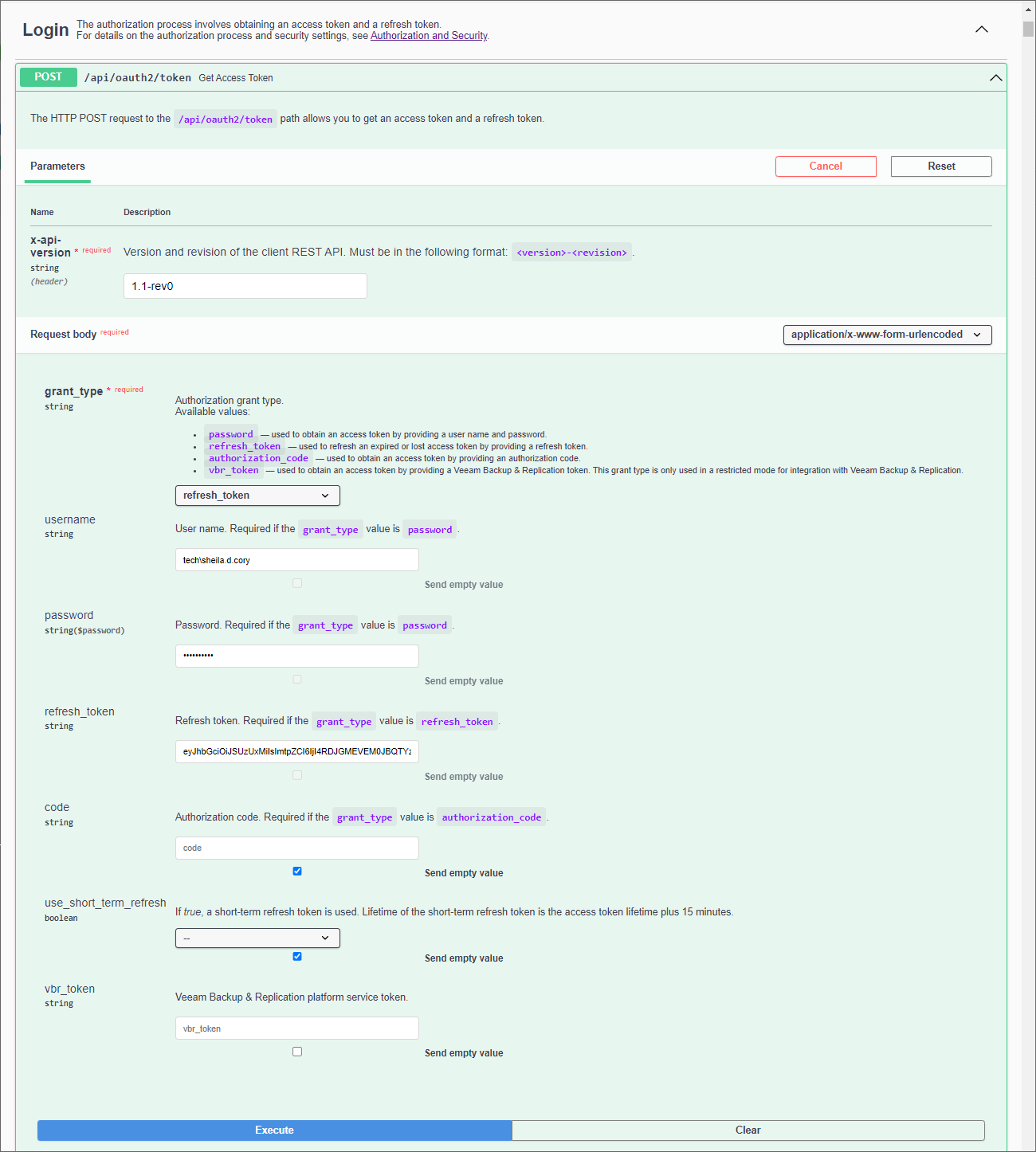
Wait for the response from the server. A successfully completed operation returns the 200 response code and a new pair of tokens in the response body.
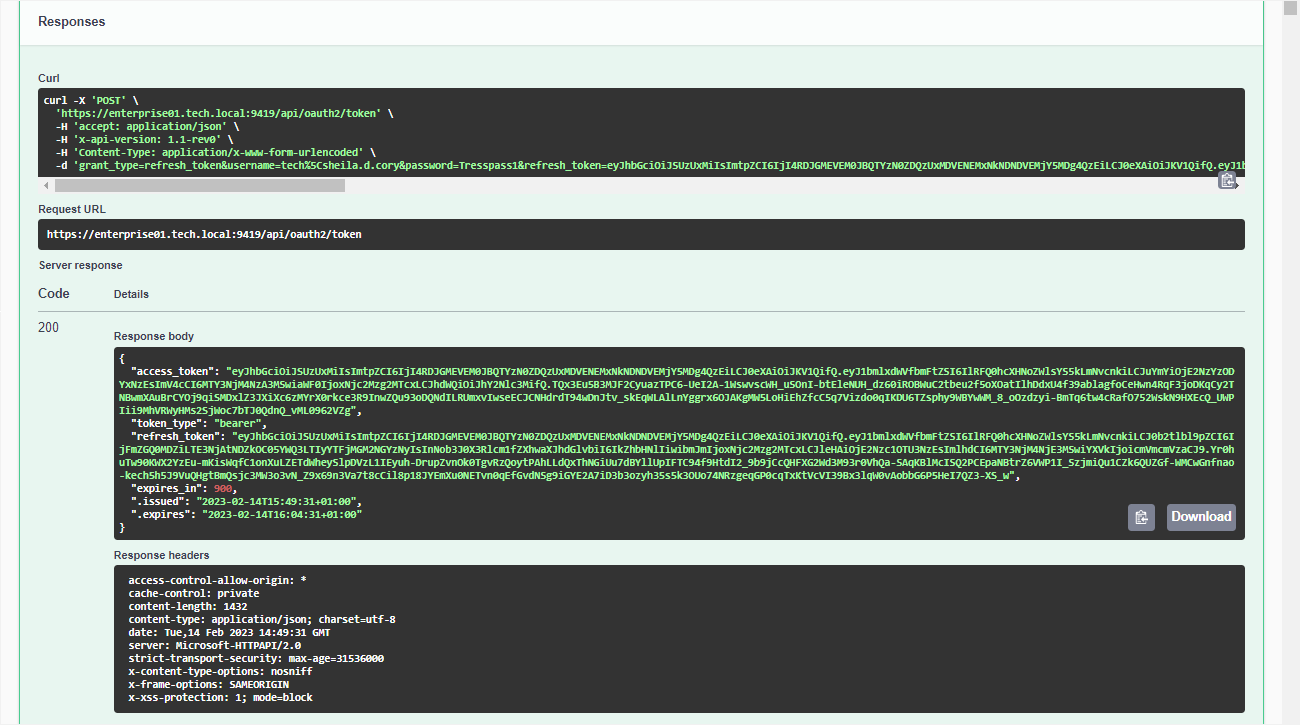
Save the access and refresh token locally for further use. To authorize your access in Swagger UI, repeat step 2.
When you finish working with the Swagger UI:
- At the top right corner of the Veeam Backup & Replication REST API page, click Authorize.
- In the Available authorizations window, click Logout.
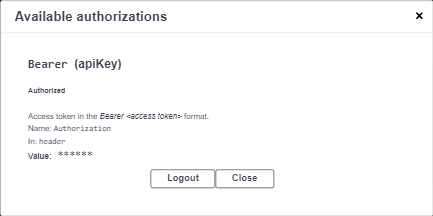
After you get authorization, you can send HTTP requests to Veeam Backup & Replication REST API collections and resources in the Swagger UI.
To send a request:
On the Veeam Backup & Replication REST API page, expand a resource to which you want to perform an operation.
In the list of request methods, click the required method.
In the expanded method window, click Try it out.
Specify parameter values if required.
Click Execute.
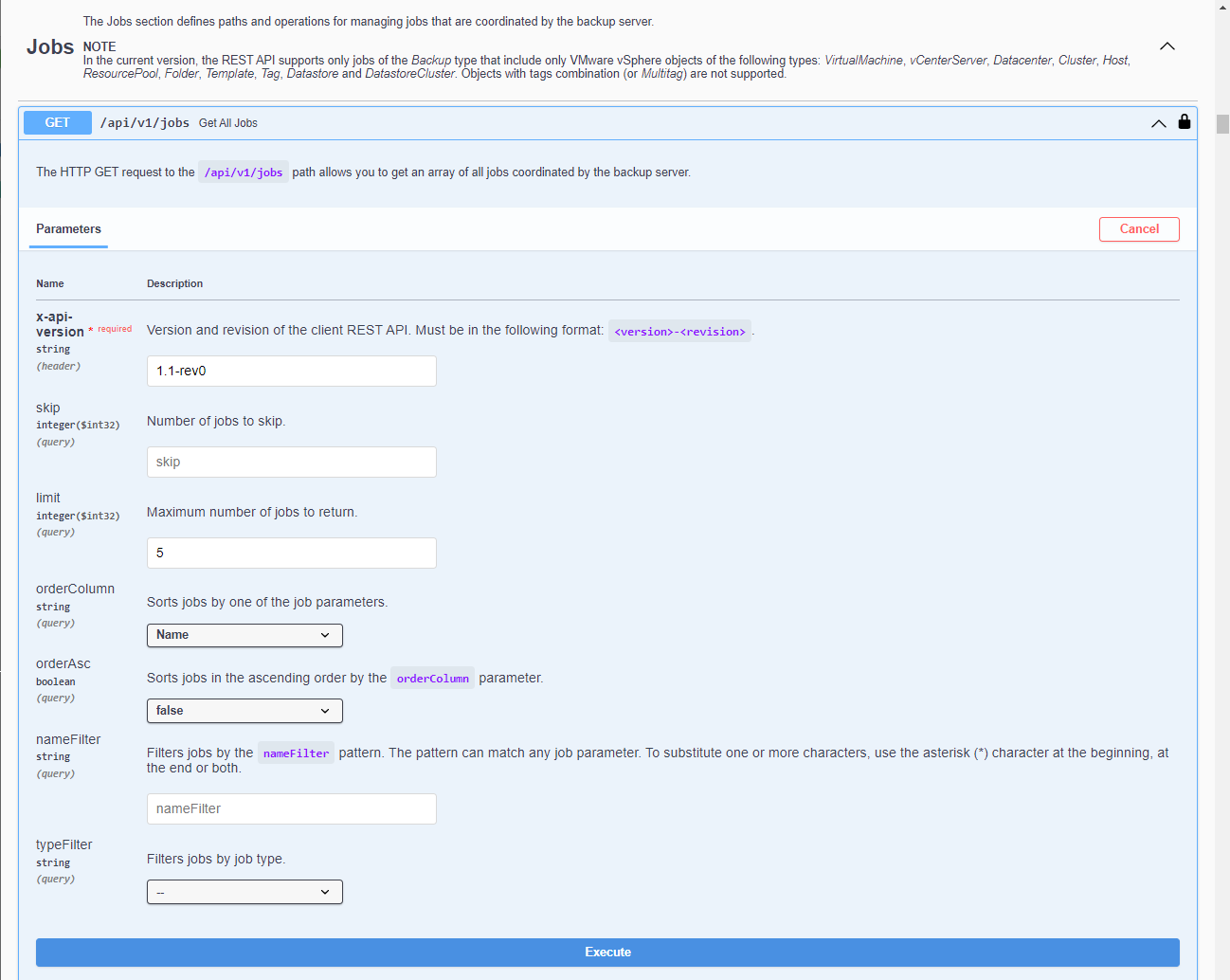
The Swagger UI returns a response body as well as a response code and response headers. Additionally the Swagger UI generates a curl command and a URL for your request.
TIP
You can download a server response in the JSON format. To do that, in the expanded method window, click Download at the lower right corner of the Response body field.
